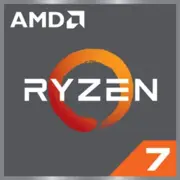AMD Ryzen 7 4700G

AMD Ryzen 7 4700G: Comprehensive Review of the Processor for Budget PCs and Multimedia (2025)
Key Features: Zen 2 in a Compact Form Factor
The AMD Ryzen 7 4700G processor, released in 2020, remains a popular choice for budget builds by 2025 due to its combination of power and integrated graphics. Its Zen 2 architecture and 7nm manufacturing process provide a balance between performance and energy efficiency.
- 8 cores and 16 threads with frequencies ranging from 3.6 to 4.4 GHz handle multitasking with ease.
- Integrated Radeon Vega 8 graphics (with 8 compute units) are a key feature, replacing a discrete graphics card in less demanding scenarios.
- 8MB of L3 cache and a TDP of 65W make it cooler than competitors like the Intel Core i7-11700.
- Geekbench 6 results: 1643 (single-core) and 7548 (multi-core) — sufficient for handling demanding applications such as Blender or Adobe Premiere.
Key Features:
- Support for PCIe 3.0 (on A520 chipsets) and PCIe 4.0 (on B550/X570).
- Precision Boost 2 and StoreMI technologies for performance optimization.
- Overclocking capability (PBO) on compatible motherboards.
Compatible Motherboards: AM4 Socket and Chipset Choices
The Ryzen 7 4700G uses the AM4 socket, allowing installation on motherboards with A520, B550, and X570 chipsets. By 2025, AM4 is considered outdated, but it remains an accessible option.
Chipset Recommendations:
- B550 ($120–$180): Optimal choice. Examples: MSI B550 Tomahawk ($150), supports PCIe 4.0, overclocking, and Wi-Fi 6.
- X570 ($200–$300): For enthusiasts. ASUS TUF Gaming X570-Plus ($220) offers improved VRM cooling and more USB ports.
- A520 ($70–$100): Budget option. Suitable for office PCs (e.g., Gigabyte A520M S2H).
Important: PCIe 4.0 and CPU overclocking features are unavailable on A520 chipsets. For gaming builds, it is better to choose B550.
Memory: DDR4 and Optimization
The processor supports DDR4 with speeds of up to 3200 MHz (officially), but many users overclock memory to 3600–3800 MHz.
- Dual-channel mode is essential: 2×8 GB or 2×16 GB.
- Recommended modules: Corsair Vengeance LPX 3600 MHz ($60 for 16 GB) or Kingston Fury Renegade.
- DDR5 is not supported — a limitation of the AM4 platform.
Power Supply Units: Calculating for Tasks
With a TDP of 65W, the Ryzen 7 4700G does not require a high-powered PSU, but it is important to consider other components:
- Without a discrete graphics card: A 450W unit is sufficient (for example, Corsair CX450, $55).
- With an NVIDIA RTX 3060 level GPU: A PSU in the 550–650W range (EVGA 600 GD, $70).
- For overclocking: Choose models with a power reserve (Seasonic Focus GX-750, $110).
Tip: Do not skimp on the PSU — low-quality units can reduce system stability.
Pros and Cons of Ryzen 7 4700G
Pros:
- Powerful integrated graphics (gaming in Full HD at low settings: CS:GO — 90–120 FPS, GTA V — 45–60 FPS).
- Low power consumption and heat output.
- Affordable price ($200–$250 in 2025).
Cons:
- Lack of PCIe 5.0 and DDR5 support.
- Zen 2 architecture is inferior to Zen 3/4 in single-core performance.
- Limited upgrade potential: AM4 is being replaced by AM5.
Use Cases
1. Office and Multimedia: Fast operation with browsers, office applications, and 4K video.
2. Light Gaming: Games like Fortnite or Dota 2 at medium settings.
3. Work Tasks: Rendering, code compilation, and virtualization thanks to 8 cores.
Example: A build with Ryzen 7 4700G + 32 GB DDR4 + NVMe SSD can handle video editing in DaVinci Resolve in real-time.
Comparison with Competitors
- Intel Core i5-12400 ($180): Better in single-core tasks, but weaker integrated graphics (UHD 730).
- Ryzen 5 5600G ($160): 6 cores, Vega 7 — a choice for those not needing 8 cores.
- Ryzen 7 5700G ($250): Zen 3, 10–15% faster in games and applications.
Conclusion: The 4700G outperforms Intel in graphics tasks but lags behind the new Ryzen 5000/7000 series.
Building Tips
1. Cooling: The boxed Wraith Stealth cooler is adequate, but for overclocking, consider the DeepCool AK400 ($35).
2. Storage: An NVMe SSD is essential (for example, WD Blue SN580 1 TB, $70).
3. Case: Choose models with ventilation (Cooler Master MasterBox Q300L, $60).
Example Build for $600:
- CPU: Ryzen 7 4700G ($200)
- Motherboard: MSI B550M Pro-VDH WiFi ($130)
- Memory: 2×16 GB DDR4-3600 ($90)
- Storage: 1 TB NVMe ($70)
- PSU: Corsair CX550 ($65)
- Case: Zalman S2 ($45)
Conclusion: Who is the Ryzen 7 4700G Suitable For?
This processor is an ideal choice for:
- Budget PCs without a discrete graphics card.
- Office and multimedia systems with ample power for everyday tasks.
- Users planning to add a GPU later (for example, after new models are released).
Why in 2025? Despite the release of Ryzen 8000 on AM5, the 4700G remains an attractive option for those not ready to pay extra for DDR5 and PCIe 5.0. Its price and availability on the secondary market (though the article focuses only on new devices) make it a "workhorse" for basic tasks.
Alternative: If your budget allows, consider the Ryzen 5 8600G (Zen 4, RDNA 3 graphics), but its price ($300+) may not be justified for simple tasks.
Basic
CPU Specifications
Memory Specifications
GPU Specifications
Miscellaneous
Benchmarks
Compared to Other CPU
Share in social media
Or Link To Us
<a href="https://cputronic.com/cpu/amd-ryzen-7-4700g" target="_blank">AMD Ryzen 7 4700G</a>